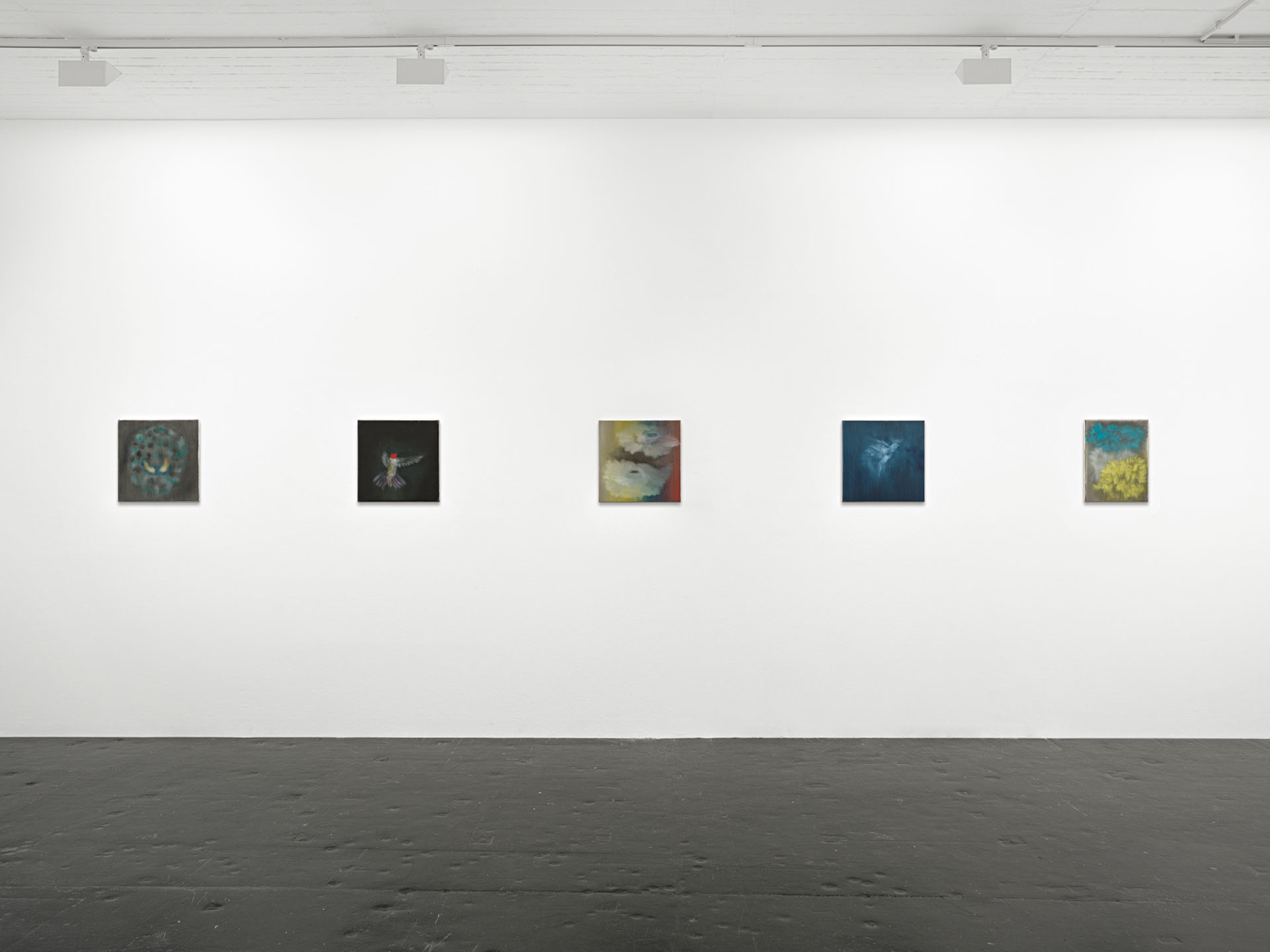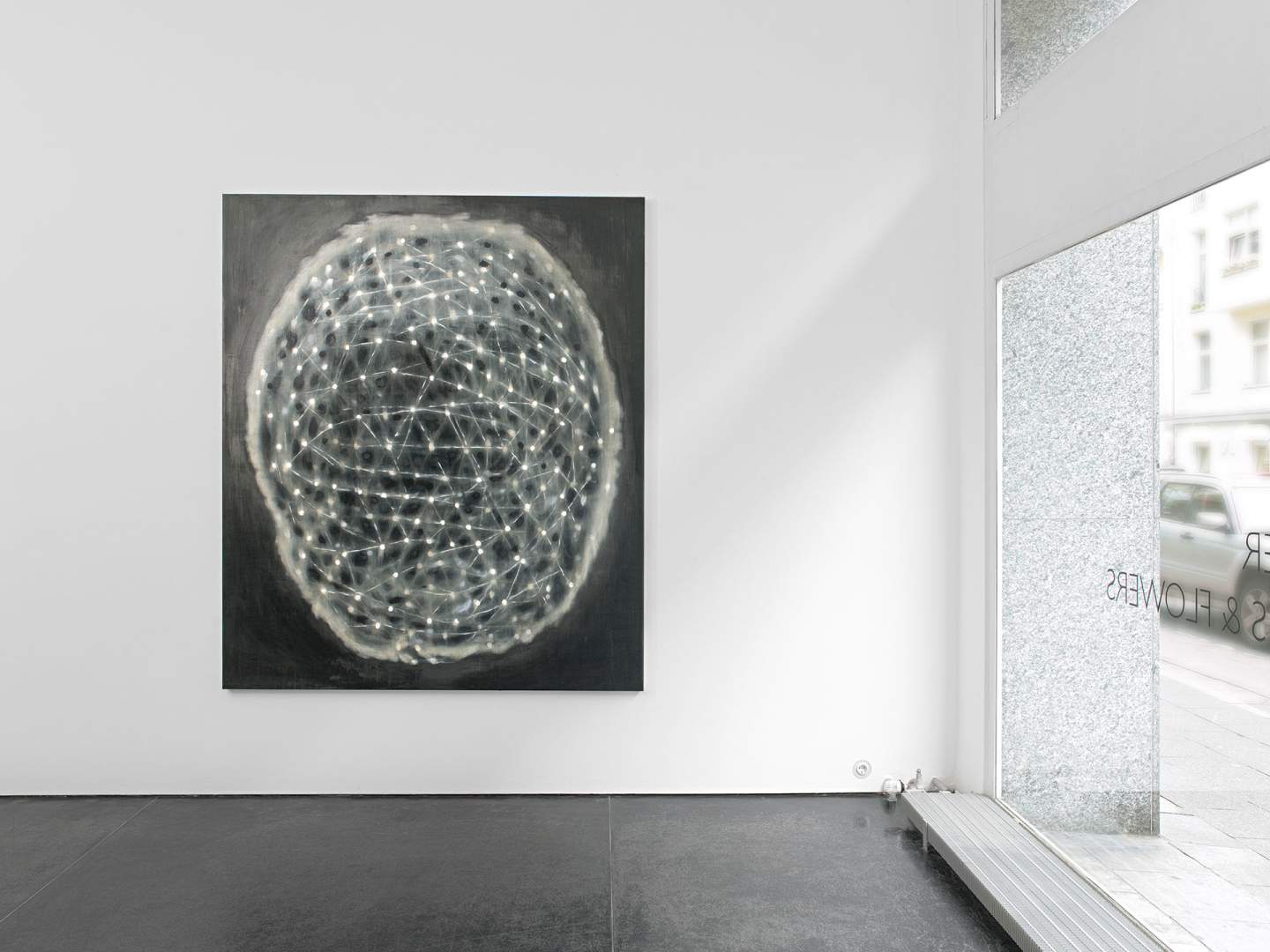BIRDS & BRAIN & FLOWERS
JABLONKA PASQUER PROJECTS
Ross Bleckner
September 8th – November 3rd, 2012
Die Jablonka Galerie und Jablonka Pasquer Projects freuen sich, neue Arbeiten des amerikanischen Künstlers Ross Bleckner zu präsentieren.
Der 1949 in New York City geborene Maler Ross Bleckner wird als einer der Protagonisten der Op‐Art gesehen – eine Stilrichtung der bildenden Kunst, die sich in den 1960er Jahren entwickelte und mit der optischen Täuschung des Betrachters spielt.
Seine aktuellen in der Jablonka Galerie und bei Jablonka Pasquer Projects gezeigten Werke, zeugen von Bleckners Interesse an Unschärfe, an Desillusion, daran, Dinge zu vermischen, um deren Identität nicht vorhersehbar, entschlüsselbar zu machen.
Verdeutlicht wird dies beispielsweise durch die Darstellung einer Taube, die konturenlos durch das Dunkel der Nacht gleitet. Sie gehört zu den „Birds“ und „Flowers“ Arbeiten, die in der Jablonka Galerie ausgestellt sind.
Sein großes Interesse an Hell und Dunkel, am Wechselspiel zwischen Licht und Schatten begründet der Künstler sowohl technisch als auch metaphorisch: „I’d rather bring dark out of light than layer dark over night. It’s just my optimism, not infantile, but the childlike part of my brain that wants to make things better, make things works. There’s light at the end.“
Die kontinuierliche Auseinandersetzung Bleckners mit der Vergänglichkeit spiegelt sich auch in den „Brain“ Arbeiten wieder, die bei Jablonka Pasquer Projects gezeigt werden. Dargestellt sind menschliche Gehirne, umzogen von feinen Linien, die mit kleinen Punkten verknüpft sind. Anreiz findet Bleckner in mikroskopischen Bilder und detaillierten medizinischen Illustrationen, die ihm zugleich auch als Zeugnis der Sterblichkeit dienen und Bezug auf die Diagnose des Vaters nehmen, der an Krebs erkrankte. Auch die Arbeit „My sister’s brain“ (2012) fügt sich in diese Auseinandersetzung ein. Vorlage für das großformatige Bild war der Scan des Gehirns seiner Schwester, die an Schizophrenie erkrankte. Bleckners Interesse an der Krankheit des Vaters und der Schwester korrespondiert mit seiner langjährige Auseinandersetzung mit Krankheitsverläufen oder wie er es beschreibt: „The idea that the body is so perfect, until it’s not perfect. It’s a fragile membran that separates us from disaster.“
Ross Bleckner wurde 1949 in New York City geboren und wuchs in Hewlett, NY, auf. 1971 Bachelor of Arts an der New York City University und 1973 Master of Fine Arts am California Institute of the Arts, Valencia, CA.
Bleckners Werke befinden sich heute in großen Museen wie im Museum of Modern Art und im Whitney Museum of American Art in New York. Zahlreiche Einzel- und Gruppenausstellungen. Unter anderem im San Francisco Museum of Modern Art, San Francisco 1988; Kunsthalle Zürich, Zürich 1990; Kölnischer Kunstverein, Köln 1991; Martin Gropius Bau, Berlin 1991; Moderna Museet, Stockholm 1991; Museum of Modern Art, New York, 1994; Guggenheim Museum, New York 1995; Reina Sofia, Madrid, 1996; Whitney Museum of American Art, New York 1999; L. A. County Museum, Los Angeles, 2001; Kunstmuseum Luzern, Luzern 2003; Esberg Art Museum, Esberg, Denmara, 2004; Zentrum Paul Klee, Bern, 2008; Kawaguchiko Museum of Art, Yamanashi Pref. 2011.
The Jablonka Gallery and Jablonka Pasquer Projects are pleased to present new works by American artist Ross Bleckner.
Born in New York City in 1949, painter Ross Bleckner is regarded as one of the protagonists of the Op Art movement – a style of visual arts developed in the 1960s which plays with optical illusions.
The works that are currently on display in the Jablonka Gallery and at Jablonka Pasquer Projects bear witness to Bleckner’s interest in blurred images and disillusion – in mixing up things in such a way that their identity cannot be foreseen or deciphered.
For instance, this is illustrated by an image of a dove gliding contourlessly through the night darkness. This is one of the “Birds” and “Flowers” works being exhibited in the Jablonka Gallery.
The artist explains his great interest in light and darkness, in the interplay between light and shade in both technical and metaphorical terms: “I’d rather bring dark out of light than layer dark over night. It’s just my optimism, not infantile, but the childlike part of my brain that wants to make things better, make things work. There’s light at the end.”
Bleckner’s ongoing dialogue with the past is also reflected in the “Brain” works that are being shown at Jablonka Pasquer Projects. These depict human brains, surrounded by fine lines linked with small dots. Bleckner finds inspiration in microscopic images and detailed medical illustrations which serve at the same time as an indication of mortality, while also referencing the diagnosis of his father, who died of cancer. The work entitled “My sister’s brain” (2012) can also be allocated to this dialogue. The template for this outsize image was a brain scan from his sister, who was diagnosed with schizophrenia. Bleckner’s interest in his father’s and sister’s conditions stems from a longstanding fascination with disease progressions: “The idea that the body is so perfect, until it’s not perfect. It’s a fragile membrane that separates us from disaster.”
Ross Bleckner was born in New York City in 1949 and grew up in Hewlett, NY. In 1971, he graduated from New York City University with a Bachelor of Arts and then with a Master of Fine Arts from California Institute of the Arts, Valencia, CA, two years later.
Today, Bleckner’s works can be found in major museums such as the Museum of Modern Art and in the Whitney Museum of American Art in New York. His numerous group and individual exhibitions include: San Francisco Museum of Modern Art, San Francisco 1988; Kunsthalle Zürich, Zurich 1990; Kölnischer Kunstverein, Cologne 1991; Martin Gropius Bau, Berlin 1991; Moderna Museet, Stockholm 1991; Museum of Modern Art, New York, 1994; Guggenheim Museum, New York 1995; Reina Sofia, Madrid, 1996; Whitney Museum of American Art, New York 1999; L.A. County Museum, Los Angeles, 2001; Kunstmuseum Luzern, Luzern 2003; Esbjerg Art Museum, Esbjerg, Denmark, 2004; Zentrum Paul Klee, Bern, 2008; Kawaguchiko Museum of Art, Yamanashi Pref. 2011.








